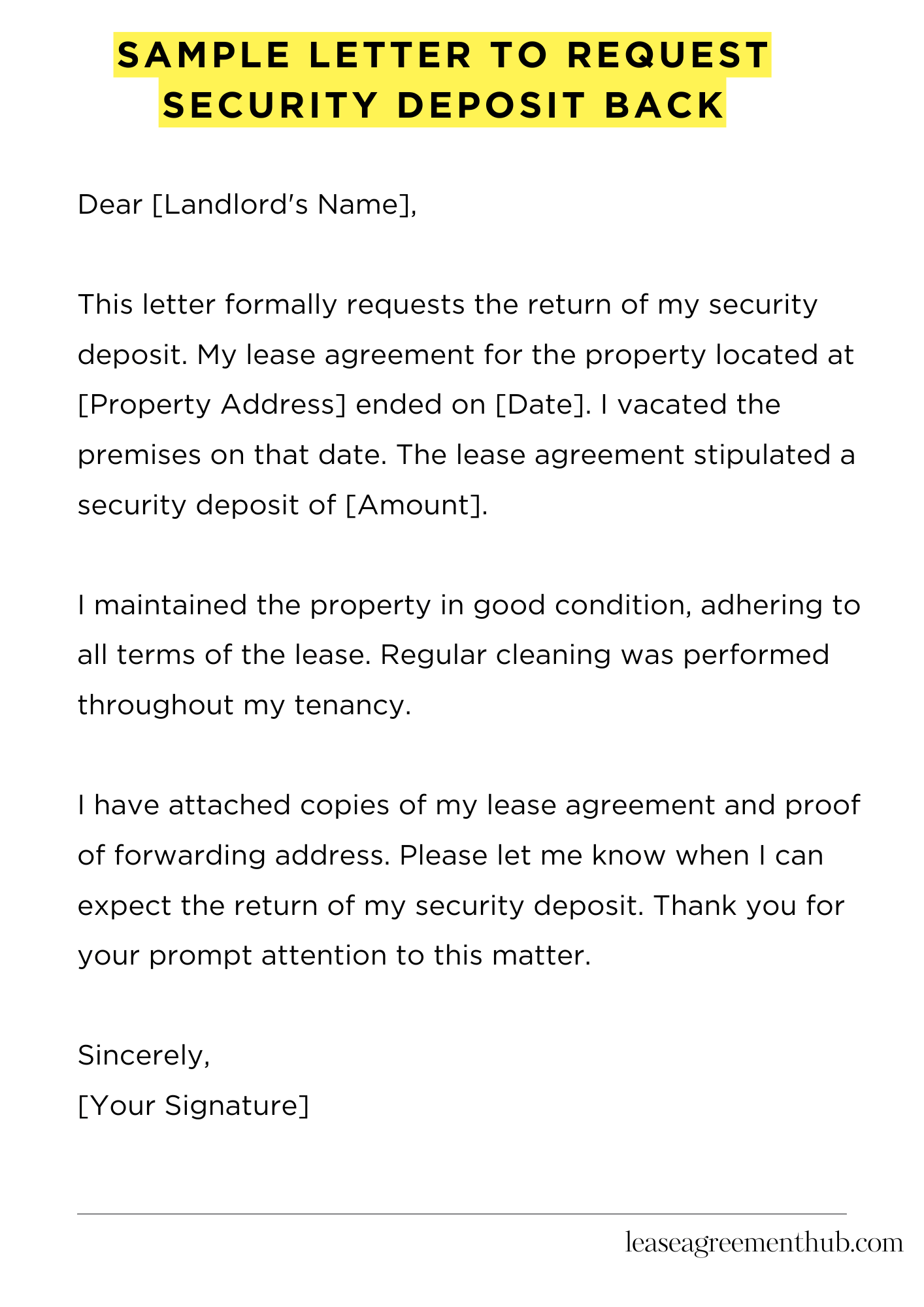Are you looking to get your security deposit back from your landlord? Our blog article provides sample letters that you can use to request your security deposit back.
We understand that writing a letter can be daunting, so we are here to help. We will be sharing templates and examples of sample letters that you can personalize to suit your situation.
With our easy-to-use samples, you can save time and effort in drafting your letter. We aim to make the process of requesting your security deposit back as simple and stress-free as possible.
Sample Letter to Request Security Deposit Back
[Your Name]
[Your Address]
[Your Phone Number]
[Your Email Address]
[Date]
[Landlord’s Name]
[Landlord’s Address]
Dear [Landlord’s Name],
This letter formally requests the return of my security deposit. My lease agreement for the property located at [Property Address] ended on [Date]. I vacated the premises on that date. The lease agreement stipulated a security deposit of [Amount].
I maintained the property in good condition, adhering to all terms of the lease. Regular cleaning was performed throughout my tenancy. There were no damages beyond normal wear and tear. I am confident that a thorough inspection will confirm this.
I have attached copies of my lease agreement and proof of forwarding address. Please let me know when I can expect the return of my security deposit. I would appreciate a response within [Number] days. If there are any deductions, please provide a detailed explanation with supporting documentation. Thank you for your prompt attention to this matter.
Sincerely,
[Your Signature]

How to Write a Sample Letter to Request Security Deposit Back
Understanding Your Rights: A Primer on Security Deposits
Before embarking on the epistolary journey of reclaiming your security deposit, ensure you’re fully apprised of your rights. Local and state laws significantly influence the landlord’s obligations and your entitlement to a refund. Familiarize yourself with these regulations; ignorance is not a viable defense in this matter. Thoroughly scrutinize your lease agreement—it’s the bedrock of your case. Note any clauses pertaining to deductions and the timeframe for reimbursement. This preliminary research is paramount.
Documenting Your Tenancy: Meticulous Record-Keeping
Maintaining a comprehensive record of your tenancy is akin to possessing a legal bulwark. Gather irrefutable evidence. This includes, but isn’t limited to, copies of your lease, rent receipts, and photographic documentation of the property’s condition both upon your arrival and departure. Should a dispute arise, these documents will serve as unimpeachable witnesses to your conscientious tenancy.
Conducting a Thorough Inspection: Pre-emptive Measures
Before vacating, conduct a meticulous, almost forensic, inspection of the property. Photograph any existing damage, noting its pre-existing nature if possible. This proactive approach can preempt spurious deductions. Document everything; a picture is worth a thousand words, especially in a legal dispute. The goal is to leave no stone unturned.
Crafting Your Request: A Formal Epistle
Your letter should be formal and businesslike. Address it to your landlord using their full name and address. Clearly state your intent: to request the return of your security deposit. Provide your forwarding address. Quantify your deposit precisely, citing the relevant aspects of your lease and any applicable laws. Remain diplomatic yet assertive.
Addressing Potential Deductions: A Measured Response
Anticipate potential deductions. If your landlord claims damages, provide a point-by-point rebuttal referencing your photographic documentation. If you disagree with any deductions, articulate your counterargument cogently and rationally. Maintain a professional tone throughout your correspondence; vituperation is rarely efficacious.
Following Up: Persistence Pays Off
If you don’t receive your deposit within the legally stipulated timeframe, send a follow-up letter. Send it via certified mail with return receipt requested. This provides irrefutable proof of delivery. Consider consulting legal counsel if your efforts remain unavailing. This is often necessary to escalate the matter further.
Legal Recourse: Navigating the Labyrinth of the Law
If amicable resolution proves elusive, you may need to explore legal avenues. Consulting a lawyer specializing in landlord-tenant disputes can be invaluable. They can advise you on your rights and represent your interests in court. Remember, your legal rights are your weapons in this fight.
FAQs about sample letter to request security deposit back
What information should I include in my letter requesting a security deposit refund?
Your letter should include your full name, address, contact information, the property address, the lease agreement dates, the amount of your security deposit, and a clear statement requesting its return. It should also specify the date you vacated the premises and reference any agreed-upon deductions.
When should I send the letter requesting my security deposit back?
Send the letter within the timeframe stipulated in your lease agreement. If no timeframe is specified, refer to your state’s landlord-tenant laws, as they typically dictate the deadline for returning security deposits.
What if the landlord claims deductions from my security deposit?
If the landlord intends to deduct from your security deposit, your letter should acknowledge their right to do so, but request itemized documentation supporting each deduction. This documentation should clearly explain the reason for the deduction and its cost.
What should I do if I don’t receive my security deposit back within the timeframe?
If you don’t receive your deposit or a response within the legally mandated timeframe, you should send a follow-up letter. If that fails to resolve the issue, you may need to consult with a tenant rights organization or pursue legal action.
Should my letter be sent via certified mail?
Sending your letter via certified mail with return receipt requested provides proof of delivery and can be beneficial in case of disputes. This proves you sent the request and the landlord received it.
Related: